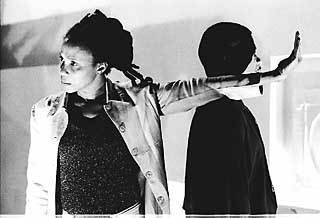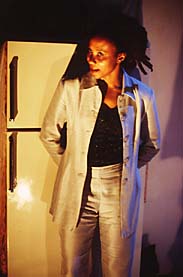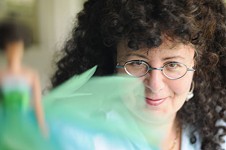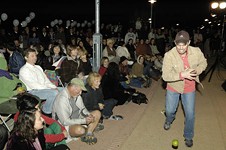Inside the Spinning, Whirling World
By C. Denby Swanson, Fri., Aug. 20, 1999
|
photograph by Bret Brookshire |
Jones' own words are a river, always deep. I tried to contain them in a formal structure. But it seemed that, in a conversation about Nigeria, creativity, and her work as a peformance ethnographer -- a cross between journalism, theatre, and anthropology -- Jones should be experienced firsthand.
This is a performance. Read it out loud.
Dr. Joni L. Jones, Associate Professor of Performance Studies, UT Austin
Oshun walked the earth at one point and became deified. And many people talked about the time when they'd make offerings at the river, which is part of the Oshun festival, one of the rituals of the Oshun festival: Feed the river, which is feeding Oshun, then she would rise out of the water and greet people. Well, [after a while] there were so many people like me, taking pictures, that she just said, "Forget it." So she doesn't come out anymore.
Take any piece of that and figure out what holds true. But what seems pretty clear is that there is this recognition that more and more people are attempting to capture spirits, and there is that kind of resistance.
This last time I was there, I went down to the river. It's such an incredibly loud experience. People just line along the river, people praying out loud, people taking their plastic bottles and gathering water to take home. All this going on, so it's like, "AAAAAh." I mean, it's like "WAAAA!" It's like a roar. You know. So there was this fish that had come out of the river, and suddenly the loudness just went up, like "RAAAAAAAAH!" It was this red and white fish that was, like, huge, and it was on a log in the river. The river water was very high, as it usually is in this rainy season. There's usually a storm the night before. I kept thinking, "Come on, Joni, what are you looking at? It's something that was caught in the river." You know? But everybody was yelling. And it was all in Yoruba, so I had no idea what people were saying, but people are like, "Oshun's doing her thing." And there's this thing, next to the log, and it's just there. It's like a fish just hanging out of the water. What is this? I was with somebody who spoke English, and I was like, "Is that her?" -- because, you know, fish are her children, and she manifests as a fish -- and he said, "Yeah yeah yeah." So. There she was. Then I went back and asked a Yoruba scholar, and when I described the fish, he said, "Well, that was her." And I said, "OK. I saw Oshun."
Yeah, a T-shirt: "I saw Oshun!" [Laughs]
But what's also interesting is there was no talk of this moment. It hadn't made its way into the general talk about the festival. The people that I work closely with, the closest living family to Oshun, there's no talk about this moment. So you see. I don't know. What do I say? You know. One day I'll figure out a story of the experience.
The field work just reminds me, it encourages me to find a way of not being definite in my writing. Being clear, being specific, but not being ... finished. Because I don't think culture operates that way. It's this fluid thing. Oshun at the river is a wonderful metaphor for that. There are times when I'm really just speechless, and I think if I try to share this moment with somebody and I can't give them the complete context, I will either reinforce stereotypes they already hold about Africans or it will be so muddled that it will be incoherent.
Which is part of the reason I do performance work around it. Because that is ephemeral and it is fluid, it is so much more like the lived experience of field work. There have been some anthropologists who have been doing a great job recently of figuring out how to make the page -- the language on the page -- less definitive. I don't have a clue. You know, I don't know how to do that. So instead I turn to performance, letting an audience come into a complete world.
I started with forensics. You know forensics. Yeah. I used to read, you know, do poetry and prose. Ohio state champion. I did debate but quickly saw the error of my ways. And everyone else saw the error of my ways, oh my word. I wasn't fast enough with arguments... Isn't that weird? But I went into the academy because I really like to teach. I have a good time. I have a real good time. The down side, I think, to my teaching, is that I'm not nearly organized enough for some students. You know? There are classes where we talk for two hours about wooo, and then I say, "Oh yeah."
My master's is from Northwestern University. The person who really got me interested in doing this work was Dwight Conquergood [head of the department at Northwestern]. I have so much respect for him and what he's done. He has done work -- is doing work -- with Laotian refugees in Chicago, and also with Chicago's street gangs. For him, they were people in his community. He lives in the projects in Chicago, so these were his neighbors.
I came into the academic stuff through something that used be called Oral Interpretation. Many departments of Oral Interpretation now call themselves Performance Studies. I was grounded in an exploration of the text; performance was a way of understanding the text. And I've done traditional theatre for quite a while, so I have all that stuff. But I work with students who don't have any of that background.
|
Joni L. Jones and Clayton Murrel in |
I think traditional theatre -- theatre done in theatre spaces, scripted work, separation of audience and performer -- speaks to a very particular population. And that's great. But there's something really important -- and I don't know, I may be at this crossroads in my own work, my own life, my own whatever -- I feel some urgency to talk to a larger, more diverse group of people. And by diverse, I mean all people everywhere. I think I'm ready to move now -- I've gotta give up some of my own baggage to do it, but I think I'm ready to move now to stuff that is more -- even more -- overtly about social change.
And I hesitate to say it; it sounds too heavy. I've gotta always remember that aesthetic theatre gives us some valuable tools for doing theatre of social change. It's not like, "Forget all that stuff." But to me, that's training for being very specific, very clear about the work that we see more obviously as reinforcing social change. And it begins to acknowledge another way -- at least an other way -- of knowing, and honoring, other ways of knowing.
I'm not going to become the Yoruba, anymore than I'm going to become Lady Macbeth ...
I'd love to try it.
Wow, that would be delicious.
But when I approach Lady Macbeth, I'm going to work putting down me for a little while and have the possibility of her power. And that's what I've got to get my students [to do]: When [you] approach real people, if you want to get a clearer sense of the world those people live in, you've got to put aside "you" in order to let [their world] pervade you.
We're really just talking about the basics of interpersonal interaction. How do you come to meet people? How do you humble yourself enough to listen? How do you empathize enough to take on the qualities that they are? And that's really basic stuff, that's basic relationship stuff. When I first started teaching [at the University of Maryland, College Park] -- that must have been 20 years ago -- I taught only one oral interpretation class and then had to teach all these communication courses: small group communication. Interpersonal communication. And the joy was in the interpersonal area. And all that [interpersonal stuff] about listening, being respectful, being open, identifying whether this is your stuff or somebody else's stuff -- all that is exactly what you do when you're trying to find a character. And it seems to me, if we really did more of that -- ah, you know, now I'm going to sound as if I'm about eight years old -- then the world would be a better place!
So.
|
|
When I teach the undergraduate courses in performance, I don't teach them as acting classes; they're explorations of identity. And I'm pleasantly surprised and pleased at the quality that can come out of that. Some of the students have never performed for an audience, but they sort of get it and are able to find the appropriate physical, vocal, spiritual detail to momentarily encourage them to see somebody other than themselves.
For me, those classes become a way for them to look at issues of race and how race is performed. How do you perform your own race? How is that going to interfere with performing the race of the person in the class, you know? That's what I'm interested in, in those undergraduate classes and in the graduate courses to a large extent as well.
In the fall, I'm teaching a new undergraduate course that I've started called Performance Research. The idea of the class is exploring some theory through performance. So I decided I would do something I wanted to do years ago. It took me way back to my oral interp origins. It's a novel by Gwendolyn Brooks called Maud Martha, and I'm finally going to adapt it. And the students in this class will perform it. It will have dramaturgs and assistant directors, and, you know, people will learn those skills. And because most of the characters in the novel are black and most of the students are going to be white, I get to explore race again. This class -- the rigor in this class will be: You gotta go with me on this journey. The [students] are going to have to help me create this script, this adaptation. And they're going to have to go into the field and find images for the people in the novel. Like you were saying, what Caryl Churchill does. Emily Mann. And I think -- and I've got to breathe deep, let it go -- because it is, it is the academy, it is about exploration. Supposed to be exploration. It's huge. It's huge.
What the white students learn is that they keep bumping up against their stereotypes. And because of that, I give them full permission to perform stereotypes. Then they've gotta add detail. So we spend a fair amount, at least the first part of class, talking about the formation of stereotypes, where they come from, why they have been useful, why the brain goes that way, then we do these exercises where they get to be stereotypes.
In the summer session class, we did this one exercise -- it was well into the class, when people had gotten comfortable with one another -- where they would walk around in circles, and when I would say begin, each one of us would simultaneously go into a stereotype of a group. I had no black people in the class; it was all white students and two Latin guys. So we started with white people. It was funny. They did a lot of frat boy things. Then we did Hispanics. We did only the groups represented in the class. Then, because we're doing African-American characters, of course, we did African-Americans. All of us. It was a real lesson for me because I kept breaking concentration. I was looking at the things going on all around me. And at one point, very interesting, me and a white girl were playing rap guys and we were both interested in the same girl. And this man -- this woman -- got mad at me and pulled a gun on me! I mean, what? It's still, just, it shocks me. But ... there was such freedom in it. You know. And she was so in it. She was really great. She was really great. Just great. And I was just blown away. Blown away.
I suspect that when they did their stereotypes of white people they were, "Is that how people see me? Is that?" There's always that huge part of race that is performed but not overtly, and that is racial history. You know, how do you perform thousands of years of anybody's history?
Since [performance ethnography is] a relatively new form, I think it's appropriate to try to give an audience some clues about -- it sounds a little condescending to say how to experience it -- about what the thinking was behind the work. So then whatever the audience decides they want to use, they can see how it bumps up against the intention.
Now the difficulty is, too often the form requires that we relinquish aesthetic standards. And I do have some serious problems there. The best work would deeply engage the audience in great emotional participation and would be aesthetically satisfying, whatever that means, and would give us specifics of some culture. My students tend to do very well on specifics of a culture, either as they re-create some people in the culture or as they lecture about the culture. But because the students come from a wide range of disciplines -- as they should, it makes it the best kind of class -- the aesthetic values are all over the place. And audiences, who are much more accustomed to seeing theatre and film and television than they are ethnography, are asked to apply those standards to the work. But my feeling is that you don't have to be a good performer; you can still do first-grade performance work, if you've applied the appropriate detail, if you've really been paying attention. I might be proven wrong. Or maybe I've already been proven wrong, I don't know. But I really do think that's true.
I then bump up against my own criteria when I make it a public performance, because then, you know, all these people have not been steeped in the ideas, and the exploration of self, then they are interacting with the work and suddenly, I'm over there going, "Oh my god, that didn't work, why didn't they have more tech?" There remains a conflict between sound aesthetic values -- however we want to define that -- and work that is important and moving and self-revelatory.
When you write this, if you can say somewhere that I'm very aware when I'm teaching a class and when students do these public performances that they're going to raise all kinds of questions, that they might make people -- some people -- angry. Some people are just going to think it's sloppy, messy work, which raises questions about what we are, what's supposed to be presented in public. I think people have the impression that if you're sharing it in public, it's done. All the edges are now smoothed off. And that's not true.
I've been talking about collaborating with the Texas Fine Arts Association on a performance installation around Oshun, called Searching for Oshun. I think, at this point, we're talking fall 2000. It's a way away. Do you know that space, have you been in that space, Seventh and Congress? It's a kind of new gallery space. It's modern, all white walls. Well, my vision is, take that space and just make it this, you know, dynamic, almost overwhelming kind of world, where an audience walks in [and there are] drumming sounds and sounds of children, sounds of the river -- that would dominate: sounds of the river -- and they could walk through the experience. They'd have to take off their shoes. They could put on the little -- what we call flip-flops -- that many Nigerians wear, but they couldn't wear their own shoes. They would put on bangles associated with Oshun. Children might put on some Oshun garments. They could move through the space any way they wanted to. They could go in one section and learn some of the drum rhythms specific with Oshun. Outside, someone will be cooking the traditional meals for Oshun -- as close as I can get them -- and audience members, if you want to call them that, would participate in cleaning the vegetables. And periodically the performances would just spring up throughout the space. A woman might come through, screaming about how somebody just stole her money, and she screams screams screams screams screams. You know, what are people going to do? There might be a drummer who moves through and encourages people to dash him, as it's called, put money on his forehead, and he might get angry when they don't. There'd be somebody performing me. And hanging from the ceiling would be these pieces of text that I speak in my own voice about the complexities of being in that world, what it means to be an African-American, all of that.
I'm thinking that I would be someone who does Oriki -- space singing -- as people came in. It's a wonderful, spontaneous creation of poetry, which in that way has a kinship to rap. You honor the people that come, especially the dignitaries. You know. So I'd go up to you and I'd sing to you in spontaneous poetry. In Yoruba, which I don't speak. But my good friends [in Nigeria] are gonna help me with this when I go back. And there'd be a room, a section, that I would call maybe the Room of Knowledge, with divination. I'm not sure. You know, it's mixing spiritual and secular and commercial and all that stuff. If divination is not done, the practice of divination would be talked about, there'd be books there about Oshun, people could sit down and read if they wanted to. That's sort of the image for the whole thing. You see what I'm talking about.
I say, "Look, this is the spinning, whirling world. You have your moment inside of it." The audience has to synthesize for themselves what that world is like.











